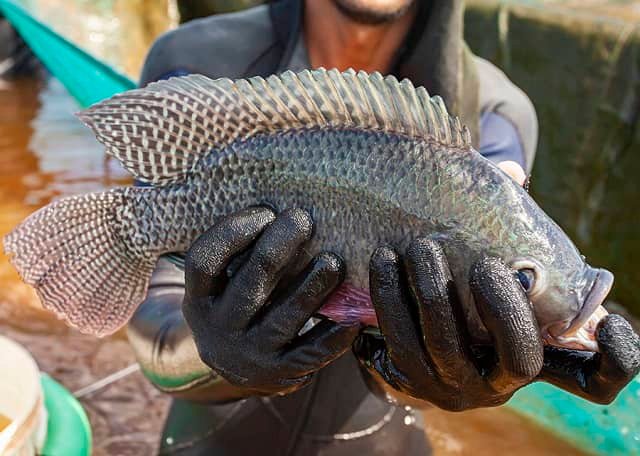
Fish are known for exhibiting an exceptional variety of sex determination and differentiation pathways, including genetic sex determination (GSD), environmental sex determination (ESD), and an interaction between GSD and ESD.
In this context, sex control in some aquaculture species is highly desirable as sexual dimorphism makes one gender preferable for cultivation due to characteristics such as growth rates, age at sexual maturity, lack of growth after maturation, and meat quality deterioration.
Nile tilapia, a species known for its sensitivity to environmental factors during gonad differentiation, has become a focal point of research in aquaculture.
Researchers from the Institute of Aquaculture and Bangladesh Agricultural University published a study discussing the complexities of sexual phenotypic changes in Nile tilapia (Oreochromis niloticus), particularly focusing on improving feminization rates through a novel approach: combining estrogen hormone treatment with elevated temperatures.
Understanding Sexual Phenotypic Changes
The critical period of gonad differentiation in Nile tilapia is marked by susceptibility to phenotypic sex changes, especially when exposed to steroid hormones and high temperatures.
One commonly used strategy is the use of exogenous hormones for the production of monosexual populations with the desired sexual genotype. However, the direct use of hormones on fish destined for human consumption has been restricted in some countries.
On the other hand, a combination of sex reversal and genetic manipulation in fish can produce genetically monosexual progeny for commercial production. In this context, hormonal treatment can be the first step, producing XX or YY populations, which will later be crossed to produce monosex offspring.
Previous studies have shown that feminizing XY males is more challenging than masculinizing XX females. However, current research seeks to push the boundaries of feminization rates by using a combination of estrogen hormone (diethylstilbestrol, DES, or 17α-ethinylestradiol, EE2) and high temperature (36 °C) during this sensitive period.
Experimental Design and Offspring Exposure
Existing feminization protocols in Nile tilapia (Oreochromis niloticus) show highly variable feminization rates and generally reduce survival in practice.
In this context, the study involved crosses with parental genotypes XX♀ × XY♂, XX♀ × YY♂, and XX♀ × XX♂. Progenies from each cross underwent various treatments, including combined estrogen hormone and high temperature, hormone alone (as a positive control), high temperature alone (as a positive control), and a negative control at 28 °C. Sexual genotypes were confirmed using sex-linked markers located on linkage groups 1, 20, and 23.
Key Results
According to the researchers, “The results demonstrate that the combined treatment of steroid hormone and high temperature during the critical period of sexual differentiation in Nile tilapia was more efficient in the feminization of genetic males compared to hormone alone in mixed-sex and XY groups.”
Combined treatments of estrogen hormone (DES or EE2) and high temperature showed significant feminization rates compared to hormonal treatment alone in all crosses, except in XX (exclusively female progeny). In particular, the combined hormonal and high-temperature treatment with DES achieved a notable 100% feminization rate in mixed-sex groups.
Survival Rates and Treatment Comparisons
Survival rates varied among treatments, and the negative control ranged between 79% and 96%. The combined EE2-high temperature treatment showed higher survival rates (ranging from 79% to 94%) compared to the combined DES-high temperature treatment (46.88% in mixed-sex groups). Similarly, survival rates were higher with EE2 alone (between 73% and 96%) compared to DES alone treatment (approximately 66%).
Conclusion
This groundbreaking study is the first to demonstrate that the combined treatment of estrogen hormone and high temperature induces higher feminization rates in Nile tilapia compared to hormonal treatment alone.
“This study demonstrated for the first time that the combined treatment of estrogen hormone and high temperature could feminize genetic males at a faster rate than hormone alone,” report the researchers.
Despite the traditionally opposing effects of estrogen hormone and high temperature on gonad differentiation pathways in Nile tilapia, this research opens new possibilities for optimizing feminization strategies in aquaculture.
The findings not only contribute to the scientific understanding of sexual phenotypic changes in Nile tilapia but also provide practical insights for the aquaculture industry seeking more efficient and sustainable breeding practices.
The study was funded by the Commonwealth Scholarship Commission (UK).
Contact
Khanam Taslima
Institute of Aquaculture
Faculty of Natural Sciences, University of Stirling
Stirling, Scotland, UK.
taslimak@bau.edu.bd
Reference (open access)
Khanam Taslima, Sarah-Louise C. Selly, Brendan J. McAndrew, David J. Penman. 2023. Combined estrogen and elevated temperature treatments induce feminization in Nile tilapia, Oreochromis niloticus, Aquaculture Reports, Volume 33, 2023, 101773, ISSN 2352-5134, https://doi.org/10.1016/j.aqrep.2023.101773.
Editor at the digital magazine AquaHoy. He holds a degree in Aquaculture Biology from the National University of Santa (UNS) and a Master’s degree in Science and Innovation Management from the Polytechnic University of Valencia, with postgraduate diplomas in Business Innovation and Innovation Management. He possesses extensive experience in the aquaculture and fisheries sector, having led the Fisheries Innovation Unit of the National Program for Innovation in Fisheries and Aquaculture (PNIPA). He has served as a senior consultant in technology watch, an innovation project formulator and advisor, and a lecturer at UNS. He is a member of the Peruvian College of Biologists and was recognized by the World Aquaculture Society (WAS) in 2016 for his contribution to aquaculture.
